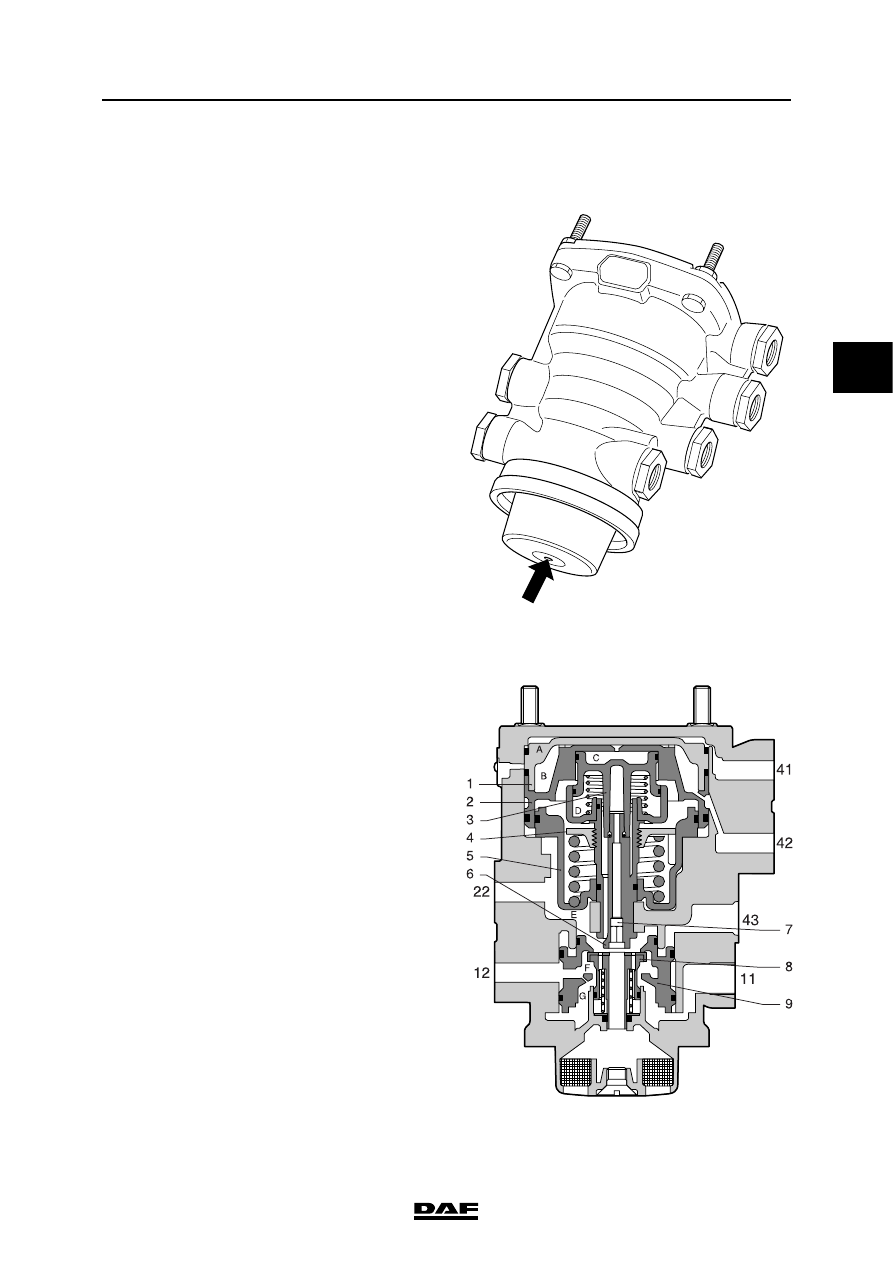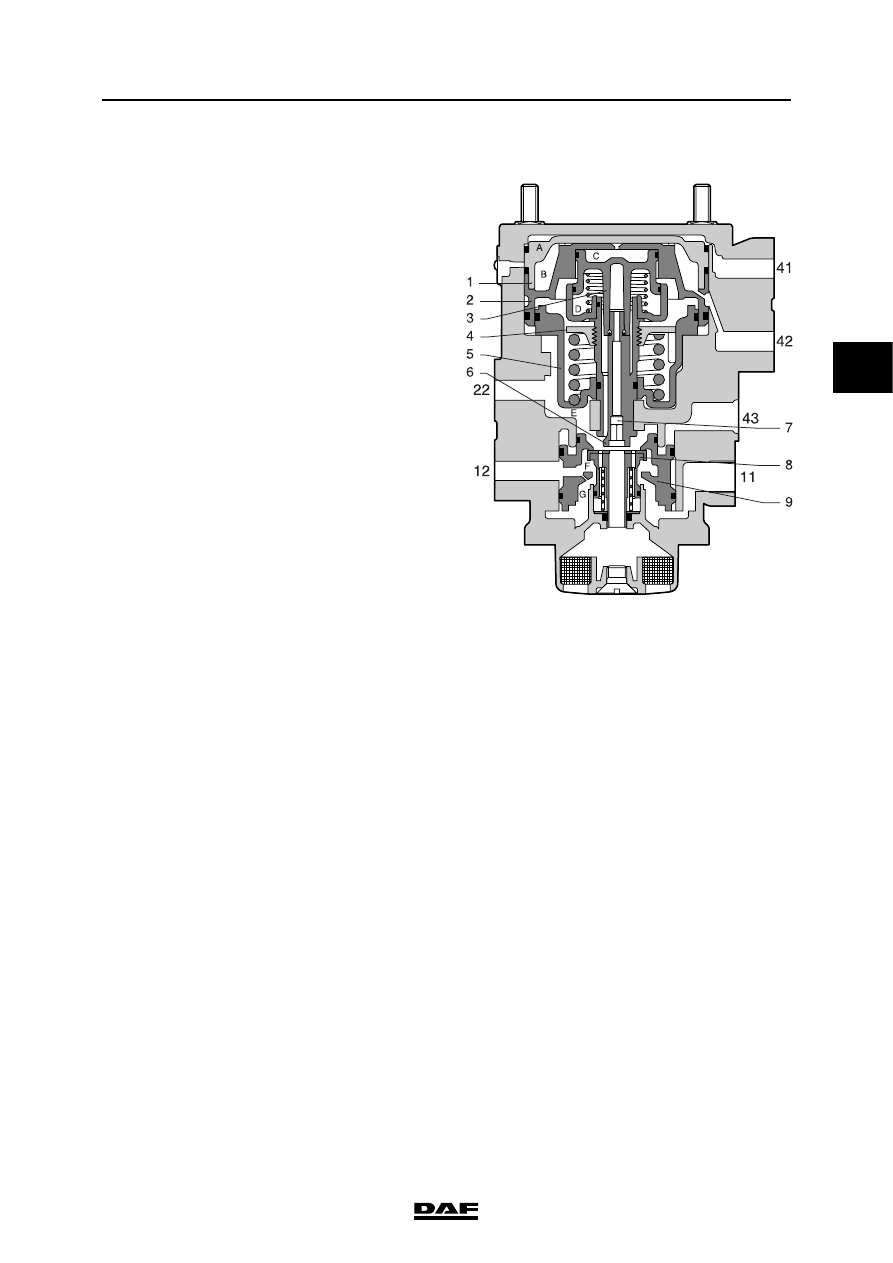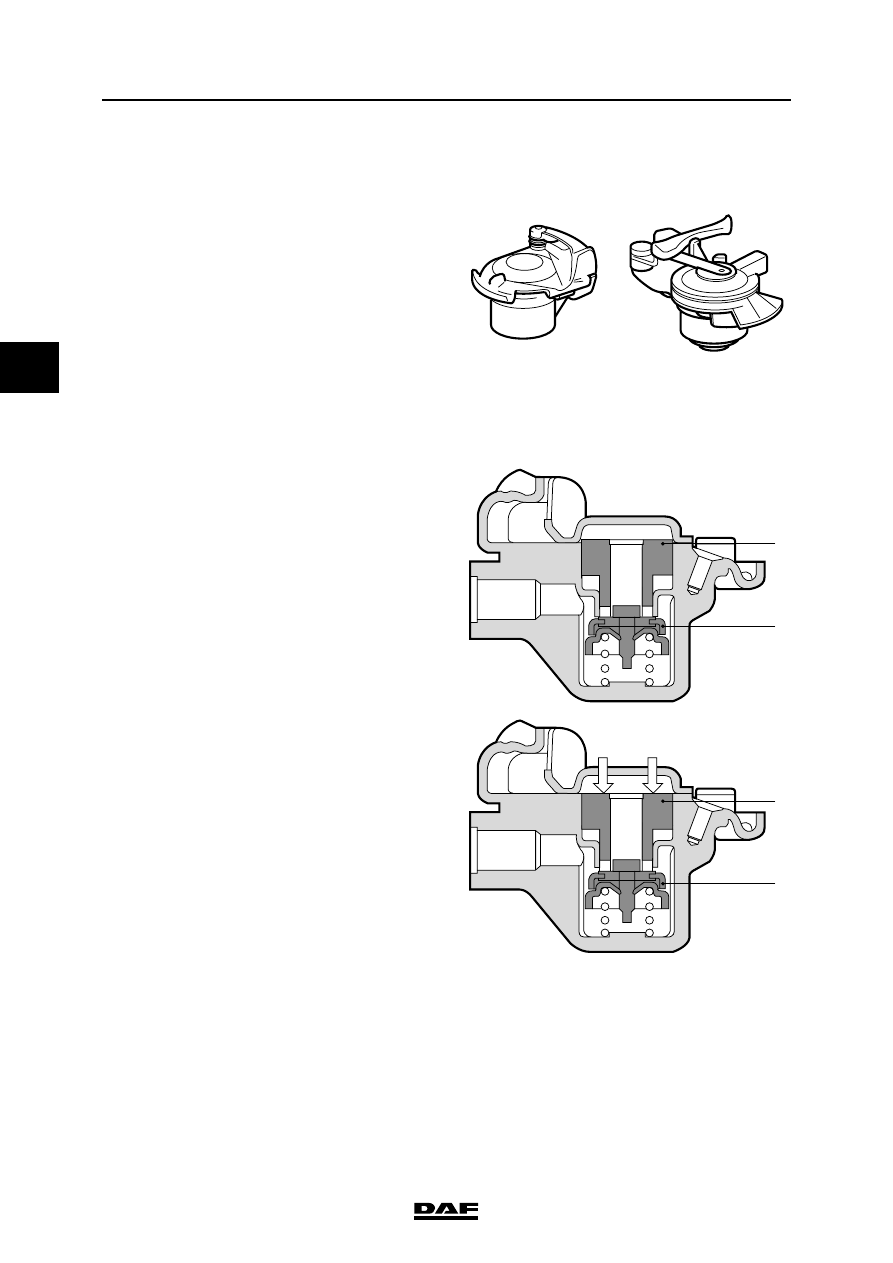DAF LF45, LF55 Series. Manual — part 452

©
200436
2-29
Description of components
OPERATION OF BRAKE COMPONENTS
ΛΦ45/55 series
6
3
2.16 TRAILER CONTROL VALVE
Purpose
The purpose of the trailer vehicle control valve is
to pass on the brake commands from the prime
mover to the trailer vehicle.
Operation
Driving
Connecting point 11 is connected to a reservoir
and connecting point 43 to the parking brake
valve. Both are pressurised and in a state of
equilibrium. The service coupling head
communicates with the ambient air via
connecting point 22, valve 8 and the bleed vent
with damper.
41
42
43
11
12
22
R600335
R600340

OPERATION OF BRAKE COMPONENTS
2-30
©
200436
Description of components
3
ΛΦ45/55 series
6
Braking with the service brake
Pressure build-up
Using the foot brake valve, circuit 1, connecting
point 41, and circuit 2, connecting point 42, are
pressurised.
This pushes down the pistons (1 and 2), causing
valve 8 to close the outlet and open the inlet. The
brake pressure at connecting point 11 can now
flow via valve 8 to connecting point 22, (yellow)
trailer vehicle service coupling head, and will
cause the trailer vehicle to brake.
Adjusting
When a pre-set output pressure has been
reached at connecting point 22, this pressure will
once again force the piston (5) upwards, thus
closing valve 8.
There is now a state of balance between the input
pressure at connecting point 41 and the output
pressure at connecting point 22.
Releasing
When the foot brake valve is released, the input
pressure at connecting points 41 and 42 falls
away. Pistons 1 and 2 are pushed upwards by the
spring under the spring retainer (4).
As a result, valve 8 is closed and the outlet
opened, linking connecting point 22 with the
bleed vent.
R600340

©
200436
2-31
Description of components
OPERATION OF BRAKE COMPONENTS
ΛΦ45/55 series
6
3
Advance
Pressure build-up
If the foot brake valve is used to build up pressure
at connecting points 41 and 42, the output
pressure at connecting point 22 will also move
piston 5 upwards, closing valve 8.
There is now a state of balance between the input
pressure at connecting point 41 and the output
pressure at connecting point 22.
Alteration
If adjusting screw 6 is turned clockwise, for
example, the spring retainer (4) will be moved
downwards, compressing the spring underneath
it. Therefore, if the operating pressure at
connecting points 41 and 42 remains the same, a
higher adjusting pressure will be needed under
piston 5. This adjusting pressure is also on the
yellow coupling head.
This increase of service pressure to the trailer
vehicle in relation to the braking pressure from
the prime mover is called advance.
For the setting procedure, see "Inspection and
adjustment".
Emergency brake
When the parking brake valve is moved into the
locking position, connecting point 43 will be
gradually bled.
Piston 9 moves upwards and valve 8 is opened.
Depending on the drop in pressure at connection
point 43, a pressure build-up will occur at
connection point 22. When a pre-set value has
been reached, valve 8 will close, so that a state of
equilibrium is achieved.
Parking brake
When the parking brake valve is in its maximum
position, causing the lever to be locked,
connecting point 43 is bled. As a consequence,
there is still output pressure at connecting
point 22.
Protection against breakage of service line
During braking, pressure will build up at
connecting point 22. The air necessary for this is
supplied from connecting point 11.
If the service line is broken, pressure will not build
up in space E, which will cause piston 9 to move
up and close against the bottom of valve 8. The
supply from connecting point 11 stagnates,
causing pressure to be delivered from connecting
point 12.
The pressure in the reservoir pipe drops and the
trailer brakes are applied.
R600340

OPERATION OF BRAKE COMPONENTS
2-32
©
200436
Description of components
3
ΛΦ45/55 series
6
2.17 COUPLING HEAD
Application
With spring-loaded valve. Fitted in the dual-line
brake system of versions with trailer vehicle
connection.
If these automatic coupling heads are applied,
there is no need for an air cock.
Purpose
To connect the air brake system of the prime
mover with that of the trailer vehicle.
Operation
The spring-loaded valve (2) in the coupling head
ensures that the system is isolated from the
ambient air.
When coupling, turn the counter head until the
claws of the two heads rest against the stop
under the locking plates. This will prevent the
coupling head from disengaging spontaneously.
Because the two sealing rings (1) are pressed
against each other, the spring-loaded valve
remains open so that an air-tight connection is
achieved. When the heads are uncoupled, the
spring-loaded valve will seal off the pipe on the
prime mover.
The coupling head is equipped with a safety cam.
This is to prevent different coupling heads being
coupled to one another.
If no trailer vehicle is hooked up, the cover of the
coupling head must be closed, to avoid fouling.
R600899
R600900
2
1
R600901
2
1

Нет комментариевНе стесняйтесь поделиться с нами вашим ценным мнением.
Текст